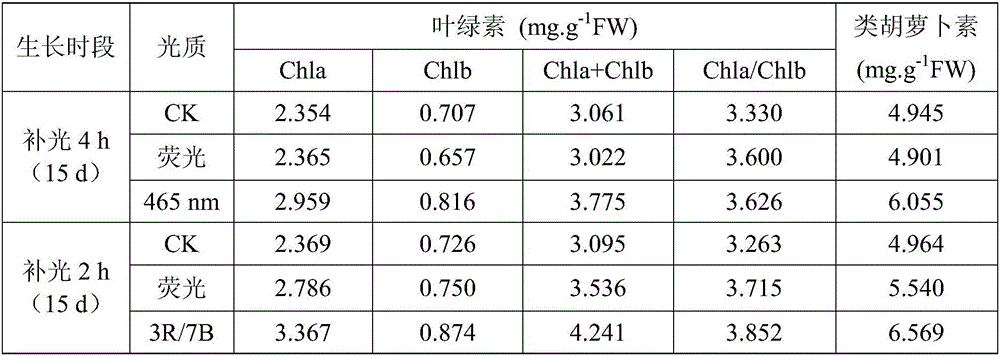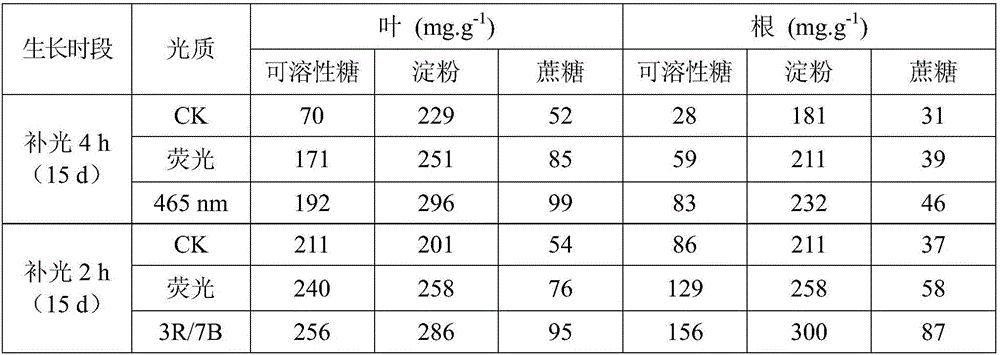Method for utilizing LED delayed supplementary lighting to promote rice seedling raising
A technology for supplementing light and rice, which is applied in the fields of rice cultivation, horticultural methods, botany equipment and methods, etc., can solve the requirements and response characteristics of plant light quality without consideration, can not well meet the needs of plant light, and has not been screened Issues such as the blue light band, to achieve the effect of improving root activity, increasing stem base diameter and strong seedling index, and increasing the activity of antioxidant enzymes
- Summary
- Abstract
- Description
- Claims
- Application Information
AI Technical Summary
Problems solved by technology
Method used
Image
Examples
Embodiment 1
[0041] 1. References for the determination of rice morphological indicators and physical and chemical indicators:
[0042] (1) Cao Jiankang, Jiang Weibo, Zhao Yumei. Guidance for postharvest physiological and biochemical experiments of fruits and vegetables. China Light Industry Press, 2007;
[0043] (2) Li Hesheng. Principles and techniques of plant physiology and biochemistry experiments. Beijing: Higher Education Press, 2007;
[0044] (3) Zhang Zhiliang, Qu Weijing. Plant Physiology Experiment Guide. Higher Education Press, 2004.
[0045] 2 Experimental methods
[0046] 2.1 Rice seedling raising
[0047] Rice seeds (indica "Huanghuazhan" (Yueshendao 2005010), bred by the Rice Research Institute of Guangdong Academy of Agricultural Sciences) were sterilized, soaked in running water at normal temperature for 48 hours, and then germinated in a box at 30°C with constant temperature and humidity (humidity 100%) for 12 hours , when the germination reaches about 0.5cm, it is so...
Embodiment 2
[0106] 1 Experimental method
[0107] 1.1 Rice seedling raising
[0108] Rice seeds (indica rice "Huang Huazhan" (Guangdong Shendao 2005010), bred by Rice Research Institute of Guangdong Academy of Agricultural Sciences) were disinfected and sterilized, soaked in running water for 48 hours, and then germinated in a 30°C light, constant temperature and humidity (100% humidity) box for 12 hours. , when the buds reach about 0.5cm, sow them into the seedling trays (size 60×30×3.5cm) spread with paddy soil, about 400 grains per tray, and cultivate them in a greenhouse under natural light conditions during the day (natural light). The conditions are: day length>12h, temperature 20-25℃, relative humidity 60±5%, average light intensity about 300μmol.m -2 .s -1; Placed in the test light environment at night for 30d (day) growth cycle supplementary light treatment, that is, from the three-leaf stage, placed in the plant growth light environment containing blue LED lights at night for ...
PUM
| Property | Measurement | Unit |
|---|---|---|
| Wavelength | aaaaa | aaaaa |
| Wavelength | aaaaa | aaaaa |
Abstract
Description
Claims
Application Information
 Login to View More
Login to View More - R&D
- Intellectual Property
- Life Sciences
- Materials
- Tech Scout
- Unparalleled Data Quality
- Higher Quality Content
- 60% Fewer Hallucinations
Browse by: Latest US Patents, China's latest patents, Technical Efficacy Thesaurus, Application Domain, Technology Topic, Popular Technical Reports.
© 2025 PatSnap. All rights reserved.Legal|Privacy policy|Modern Slavery Act Transparency Statement|Sitemap|About US| Contact US: help@patsnap.com



